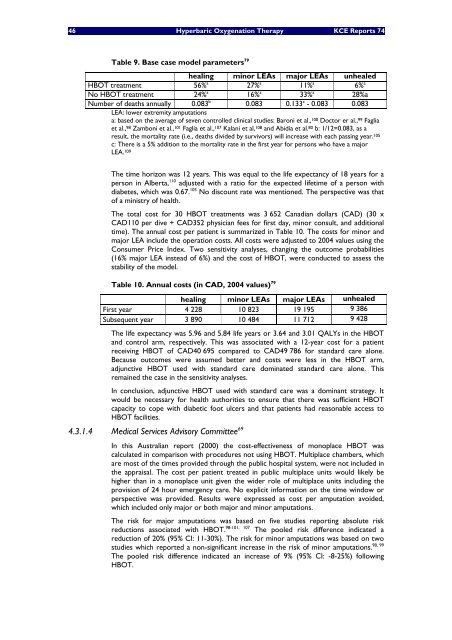Hyperbare Zuurstoftherapie: Rapid Assessment - KCE
Hyperbare Zuurstoftherapie: Rapid Assessment - KCE
Hyperbare Zuurstoftherapie: Rapid Assessment - KCE
Create successful ePaper yourself
Turn your PDF publications into a flip-book with our unique Google optimized e-Paper software.
46 Hyperbaric Oxygenation Therapy <strong>KCE</strong> Reports 74<br />
Table 9. Base case model parameters 79<br />
healing minor LEAs major LEAs unhealed<br />
HBOT treatment 56% a 27% a 11% a 6% a<br />
No HBOT treatment 24% a 16% a 33% a 28%a<br />
Number of deaths annually 0.083 b 0.083 0.133 c - 0.083 0.083<br />
LEA: lower extremity amputations<br />
a: based on the average of seven controlled clinical studies: Baroni et al., 100 Doctor er al., 99 Faglia<br />
et al., 98 Zamboni et al., 101 Faglia et al., 107 Kalani et al, 108 and Abidia et al. 80 b: 1/12=0.083, as a<br />
result, the mortality rate (i.e., deaths divided by survivors) will increase with each passing year. 105<br />
c: There is a 5% addition to the mortality rate in the first year for persons who have a major<br />
LEA. 109<br />
The time horizon was 12 years. This was equal to the life expectancy of 18 years for a<br />
person in Alberta, 110 adjusted with a ratio for the expected lifetime of a person with<br />
diabetes, which was 0.67. 105 No discount rate was mentioned. The perspective was that<br />
of a ministry of health.<br />
The total cost for 30 HBOT treatments was 3 652 Canadian dollars (CAD) (30 x<br />
CAD110 per dive + CAD352 physician fees for first day, minor consult, and additional<br />
time). The annual cost per patient is summarized in Table 10. The costs for minor and<br />
major LEA include the operation costs. All costs were adjusted to 2004 values using the<br />
Consumer Price Index. Two sensitivity analyses, changing the outcome probabilities<br />
(16% major LEA instead of 6%) and the cost of HBOT, were conducted to assess the<br />
stability of the model.<br />
Table 10. Annual costs (in CAD, 2004 values) 79<br />
healing minor LEAs major LEAs unhealed<br />
First year 4 228 10 823 19 195 9 386<br />
Subsequent year 3 890 10 484 11 712 9 428<br />
The life expectancy was 5.96 and 5.84 life years or 3.64 and 3.01 QALYs in the HBOT<br />
and control arm, respectively. This was associated with a 12-year cost for a patient<br />
receiving HBOT of CAD40 695 compared to CAD49 786 for standard care alone.<br />
Because outcomes were assumed better and costs were less in the HBOT arm,<br />
adjunctive HBOT used with standard care dominated standard care alone. This<br />
remained the case in the sensitivity analyses.<br />
In conclusion, adjunctive HBOT used with standard care was a dominant strategy. It<br />
would be necessary for health authorities to ensure that there was sufficient HBOT<br />
capacity to cope with diabetic foot ulcers and that patients had reasonable access to<br />
HBOT facilities.<br />
4.3.1.4 Medical Services Advisory Committee 69<br />
In this Australian report (2000) the cost-effectiveness of monoplace HBOT was<br />
calculated in comparison with procedures not using HBOT. Multiplace chambers, which<br />
are most of the times provided through the public hospital system, were not included in<br />
the appraisal. The cost per patient treated in public multiplace units would likely be<br />
higher than in a monoplace unit given the wider role of multiplace units including the<br />
provision of 24 hour emergency care. No explicit information on the time window or<br />
perspective was provided. Results were expressed as cost per amputation avoided,<br />
which included only major or both major and minor amputations.<br />
The risk for major amputations was based on five studies reporting absolute risk<br />
reductions associated with HBOT. 98-101, 107 The pooled risk difference indicated a<br />
reduction of 20% (95% CI: 11-30%). The risk for minor amputations was based on two<br />
studies which reported a non-significant increase in the risk of minor amputations.<br />
The pooled risk difference indicated an increase of 9% (95% CI: -8-25%) following<br />
HBOT.<br />
98, 99

















